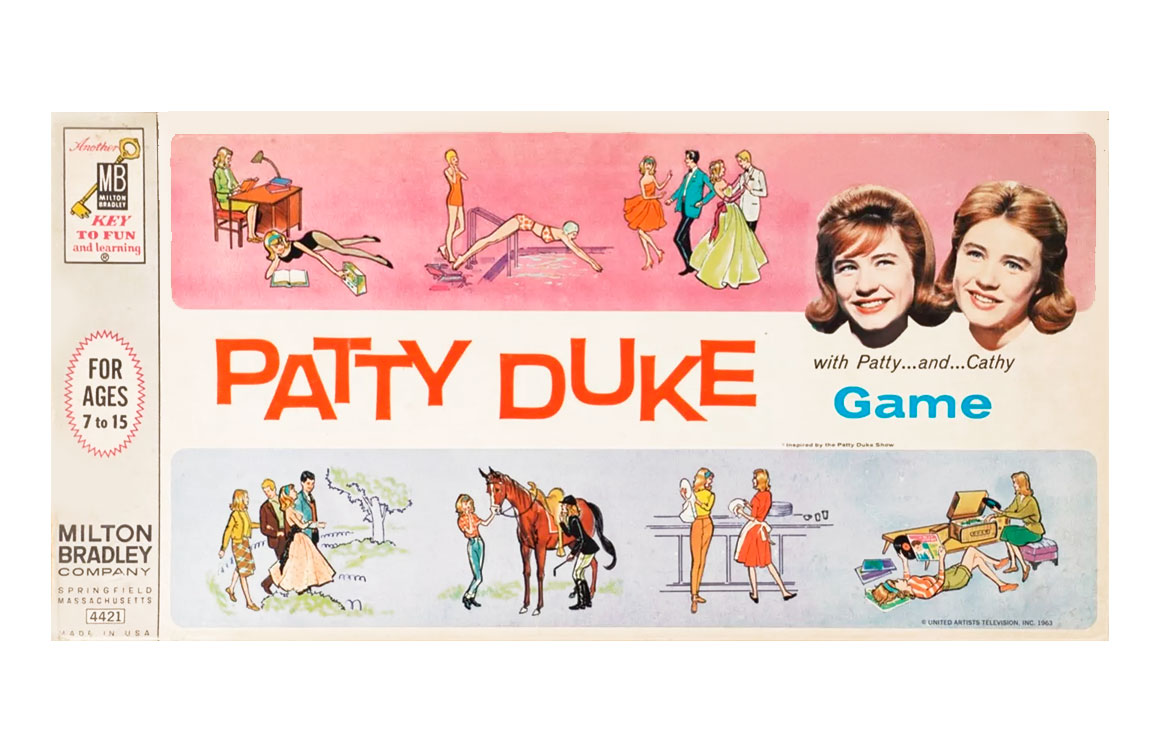Released by Milton Bradley in 1963, the Patty Duke Game was a roll-and-move boardgame that challenged players’ observation and memory skills as they worked to match cards illustrating the activities of identical cousins Patty and Cathy.
The game was based on the central characters of The Patty Duke Show, a sitcom that ran for three seasons from 1963 to 1966. The series centred around identical cousins — Patty and Cathy Lane — as they navigated life together in New York City. Child star Patty Duke portrayed both Patty and Cathy.
GAMEPLAY
The goal of the game was to match a red card with a green card that had the same number and activity. For every card illustrated with Patty enjoying an activity, there was a corresponding Cathy card.
Players were each dealt four red cards; a player was allowed to look at their own cards but the cares were kept face down so as to be hidden from the opponent(s). A series of green cards was distributed throughout the activity sections on the board. Three cards were placed face-down on each of the eight sections. The sections were illustrated with images of the cousins enjoying activities such as horseback riding, swimming, studying, dancing, playing records, dating, watching television, and washing dishes. The remaining red and green cards were placed in separate piles at the centre of the board.
Players took turns rolling the dice and moving their pawns from the start position along a coloured pathway. A variety of actions were promoted along the way. Some spaces produced no additional action, some asked players to take a red card from the pile or from another player. The pivotal stops were red squares with an arrow that pointed to an activity section. When players landed on one of these spaces, they could turn over a green card in hopes of making a match with a red card in their possession.
Before turning over a green card, players had to predict whether it would have Patty or Cathy enjoying an activity. If the player’s prediction was incorrect, they showed the card to the opponents and placed it face down back on the board. If the player was correct in their prediction, they then looked to see if the number and activity illustrated on the card matched one of their own. If it matched, the player discarded both the red and green card, moving closer to winning the game. If the number and activity did not match, the player placed the card back on the board, face down.
Wild cards gave players an advantage. If a red wild card was received at any point during the game, the player could automatically discard it — no matching required. If a green wild card was picked up and the name was what the player called before selecting it, the player could discard any one red card in their possession.
When players made a match, they were granted another roll of the dice and continued to move along the board.
The first player to discard all of their red cards won the game.
IN THE BOX
A complete game included a game board, four pawns (two girls in red and blue and two boys in yellow and green), 24 red cards, 24 green cards, and one dice. Instructions were printed inside the box top.
GAMES BASED ON TELEVISION SERIES
Milton Bradley published several games based on popular television shows: I Dream of Jeannie Game(1965), Branded (1966), The Partridge Family Game (1971), Planet of the Apes (1974), Land of the Lost (1975), another other live-action and animated favourites.
Note: If you buy something using the eBay link in this story, we may earn a small commission. Thank you for supporting independent toy journalism!


